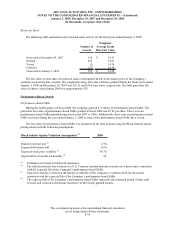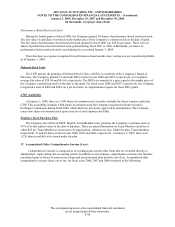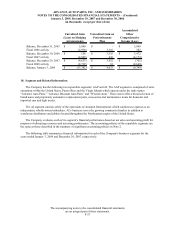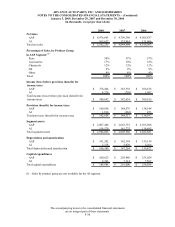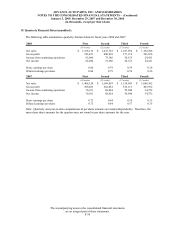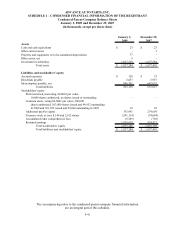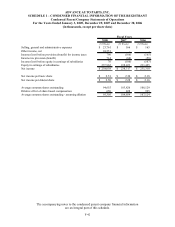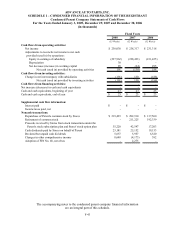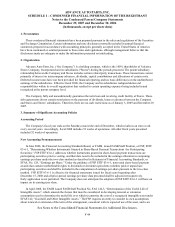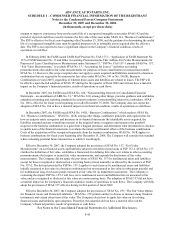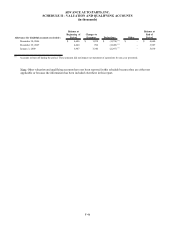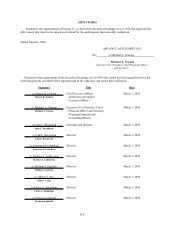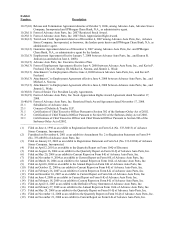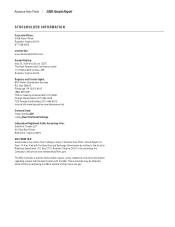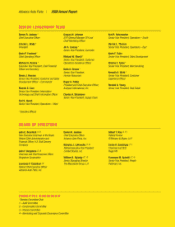Advance Auto Parts 2008 Annual Report Download - page 99
Download and view the complete annual report
Please find page 99 of the 2008 Advance Auto Parts annual report below. You can navigate through the pages in the report by either clicking on the pages listed below, or by using the keyword search tool below to find specific information within the annual report.ADVANCE AUTO PARTS, INC.
SCHEDULE I – CONDENSED FINANCIAL INFORMATION OF THE REGISTRANT
Notes to the Condensed Parent Company Statements
December 29, 2007 and December 30, 2006
(in thousands, except per share data)
See Notes to the Consolidated Financial Statements for Additional Disclosures.
F-45
attempt to improve consistency between the useful life of a recognized intangible asset under SFAS 142 and the
period of expected cash flows used to measure the fair value of the asset under SFAS 141, “Business Combinations.”
The FSP is effective for fiscal years beginning after December 15, 2008, and the guidance for determining the useful
life of a recognized intangible asset must be applied prospectively to intangible assets acquired after the effective
date. The FSP is not expected to have a significant impact on the Company’s financial condition, results of
operations or cash flow.
In February 2008, the FASB issued FASB Staff Position No. FAS 157-1, “Application of FASB Statement No.
157 to FASB Statement No. 13 and Other Accounting Pronouncements That Address Fair Value Measurements for
Purposes of Lease Classification or Measurement under Statement 13.” FSP No. FAS 157-1 amends SFAS No. 157,
“Fair Value Measurements,” to exclude SFAS No. 13, “Accounting for Leases,” and other accounting
pronouncements that address fair value measurements for purposes of lease classification or measurement under
SFAS No. 13. However, this scope exception does not apply to assets acquired and liabilities assumed in a business
combination that are required to be measured at fair value under SFAS No. 141 or No. 141(R), Business
Combinations (revised 2007), regardless of whether those assets and liabilities are related to leases. The FSP will
be effective upon the full adoption of SFAS 157 during the first quarter of fiscal 2009 and will not have a material
impact on the Company’s financial position, results of operations or cash flows.
In December 2007, the FASB issued SFAS No. 160, “Noncontrolling Interests in Consolidated Financial
Statements – an amendment of ARB No. 51.” SFAS No. 160, among other things, provides guidance and establishes
amended accounting and reporting standards for a parent company’s noncontrolling interest in a subsidiary. SFAS
No. 160 is effective for fiscal years beginning on or after December 15, 2008. The Company does not expect the
adoption of SFAS No. 160 to have a material impact on its financial condition, results of operations or cash flows.
In December 2007, the FASB issued SFAS No. 141R, “Business Combinations,” which replaces SFAS No.
141, “Business Combinations.” SFAS No. 141R, among other things, establishes principles and requirements for
how an acquirer entity recognizes and measures in its financial statements the identifiable assets acquired, the
liabilities assumed and any controlling interests in the acquired entity; recognizes and measures the goodwill
acquired in the business combination or a gain from a bargain purchase; and determines what information to disclose
to enable users of the financial statements to evaluate the nature and financial effects of the business combination.
Costs of the acquisition will be recognized separately from the business combination. SFAS No. 141R applies to
business combinations for fiscal years beginning after December 15, 2008. The Company will consider this standard
when evaluating potential future transactions to which it would apply.
Effective December 30, 2007, the Company adopted the provisions of SFAS No. 157, “Fair Value
Measurements” on our financial assets and liabilities subject to the deferral provisions of FSP 157-2. SFAS No. 157
clarifies the definition of fair value, establishes a framework for defining fair value as it relates to other accounting
pronouncements that require or permit fair value measurements, and expands the disclosures of fair value
measurements. The Company did not apply the provisions of SFAS No. 157 for nonfinancial assets and liabilities
except for those recognized or disclosed on a recurring basis (at least annually) as allowed by the issuance of FSP
No. 157-2. The deferral provided by FSP No. 157-2 applies to such items as (i) nonfinancial assets and liabilities
initially measured at fair value in a business combination (but not measured at fair value in subsequent periods) and
(ii) nonfinancial long-lived asset groups measured at fair value for an impairment assessment. The Company is
evaluating the impact FSP No. 157-2 will have on its nonfinancial assets and liabilities that are measured at fair
value and are recognized or disclosed at fair value on a nonrecurring basis. The adoption of SFAS 157 did not have
a material impact on the Company’s financial condition, results of operations or cash flows. The Company will fully
adopt the provisions of SFAS 157 effective during its first quarter of fiscal 2009.
Effective December 30, 2007, the Company adopted the provisions of SFAS No. 159, “The Fair Value Option
for Financial Assets and Financial Liabilities.” SFAS No. 159 permits entities to choose to measure many financial
instruments and certain other items at fair value. The Company elected not to apply fair value on its existing
financial assets and liabilities upon adoption. Therefore, this adoption did not have a material effect on the
Company’s financial position, results of operations or cash flows.


